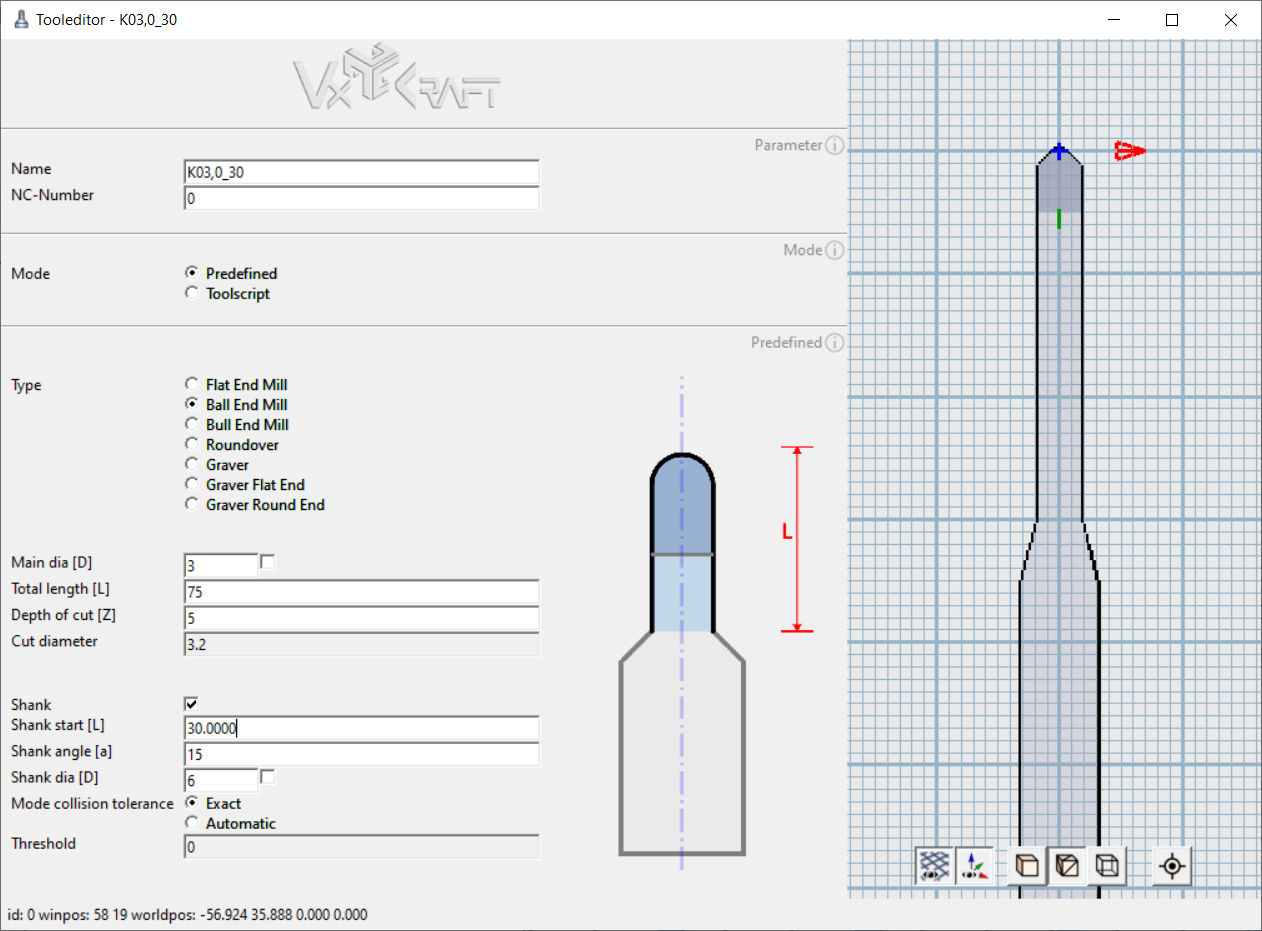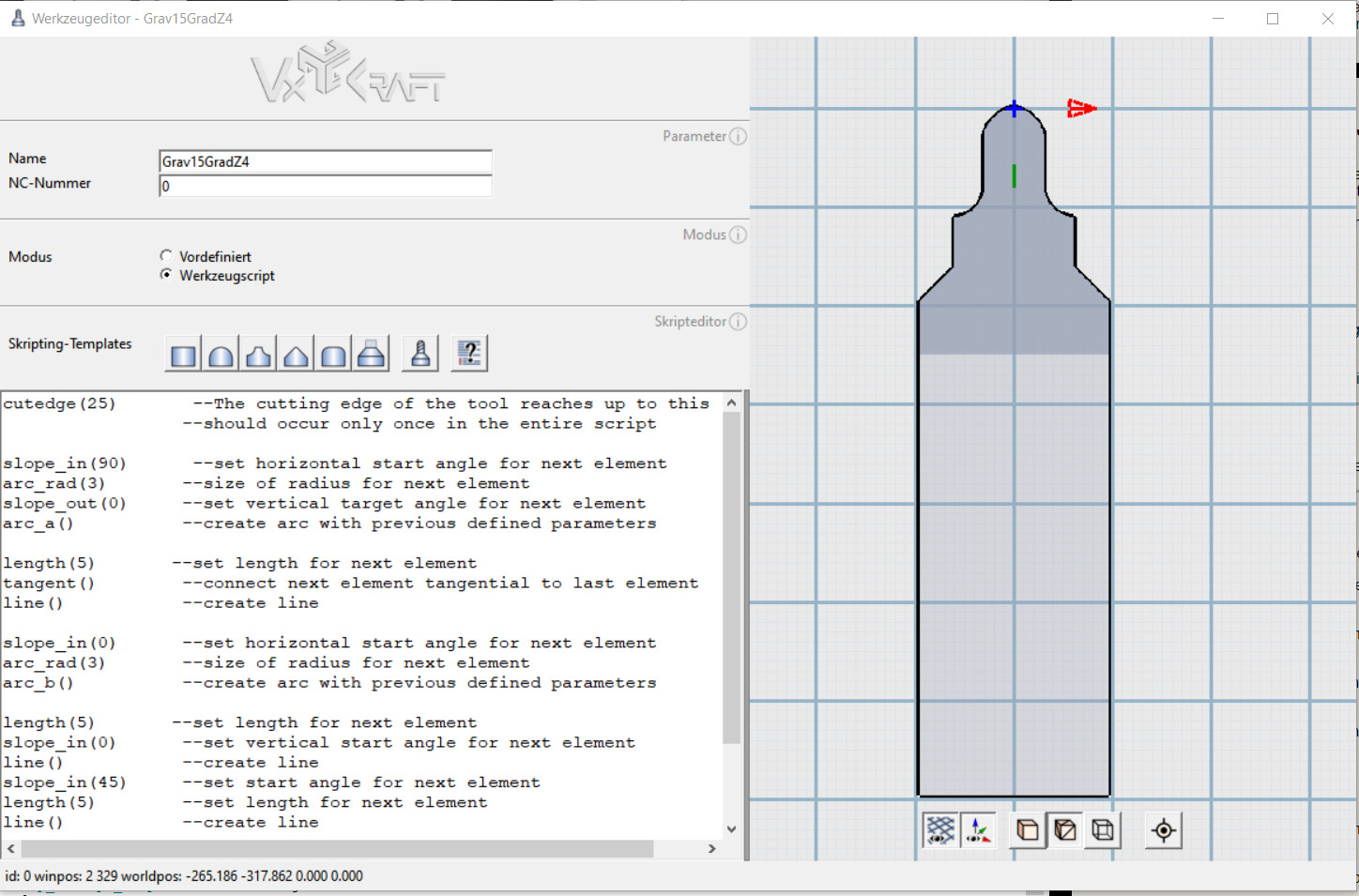Tool editor
The tool editor allows you to create the tool geometry and define basic parameters for milling tools.
 © vxcraft.com
© vxcraft.comIn the tool editor window, there is an area for data entry on the left side. Depending on the selected mode, two options are available. Either a script editor is available for experienced users and complex tool geometries, or a set of parameters for predefined cutter types is shown. In this case, a graphical scheme is also available to assist in entering the particular parameter selected.
On the right side of the window is the render window, which shows a two-dimensional preview of the milling tool. Here you can check the visual representation of your tool in real time and adjust the parameters to ensure that the tool has been defined correctly.
Angle specifications in the tool geometry
Unless otherwise specified (e.g. the common specification of an acute angle for engraving tools), all angles relating to the tool geometry refer to the tool axis. The values lie between 0° (parallel to the tool axis) and 90° (perpendicular to the tool axis).
Mode
The mode selection determines how the geometry of the milling tool is created.
Mode "Predefined"
By selecting a predefined cutter type and setting some parameters, the tool geometry can be created quickly and easily in this mode.
A schematic representation of the tool is located to the right of the input fields and serves as an aid by highlighting the area of the currently selected parameter. The proportions, lengths and angles in the representation may differ from the actual tool geometry.
Type
The tool type determines the cutting tip of the predefined tool.The following tool types are available:

Flat End Mill
A common universal tool suitable for 3D roughing operations, for milling grooves and for complete machining of vertical surfaces and flat areas.

Ball End Mill
Mainly used for prefinishing and finishing 3D contours.

Bull End Mill <PRO>
Similar to the Ball End Mill, but with a rounded face corner for roughing and finishing operations and for machining 3D contours.

Roundover <PRO>
A form cutter for fast rounding of 2D edges. The flat face is also used as a cutting edge.

Graver
For engraving fine structures.

Graver Flat End <PRO>
A special form of graver that can also be used to finish end faces. Suitable for roughing and pre-finishing engravings.

Graver Round End <PRO>
This special form of the graver's can be used to cut off end faces and machine 3D contours. Also suitable for roughing and pre-finishing engravings.
Main diameter
Defines the nominal diameter of the milling tool.
Conicity
When enabled, this option allows the cutting geometry to be tapered so that the tool becomes narrower along its length from shank to tip.
Total length
Defines the total length of the milling tool from the tip to the end of the shank.
Depth of cut
Indicates the maximum cutting depth up to which the tool has a cutting edge.
Resulting cut diameter
This dimension is automatically calculated from the combination of depth of cut, major diameter and taper. VxCraft uses this dimension for some job calculations, among others.
Cut angle
Defines the point angle for gravers, which specifies the angle between the two cutting edges.
Diameter tip
Specifies the diameter of the flattened face for special engraving tools.
Cut radius
Specifies the radius for the rounded face cutting edge.
Shank <PRO>
If activated, a shank geometry is added to the tool.
Shank start <PRO>
Defines the starting height of the shank geometry, that is, the distance between the tool nose and the start of the shank transition.
Shank angle <PRO>
Specifies the transition angle between nominal diameter and shaft diameter.
Shaft diameter <PRO>
Defines the nominal diameter of the shank.
Shaft taper <PRO>
When enabled, this option allows the shank to be tapered so that it becomes narrower along its length from the end of the shank to the start of the shank.
Collision parameters
Mode collision tolerance
The collision tolerance mode defines how the calculation of potential collisions is handled when creating and simulating tool paths.
Due to the various options for optimizing tool paths (see chapter "Job parameter path optimization") even the smallest deviations of the path can lead to detected collisions. The choice of mode can influence this behavior.
Exact:
The exact mode is suitable for highly sensitive tools or if tool path optimization has been deactivated in the job. Here, any potential collision is strictly detected and reported.
Automatic:
The automatic mode calculates a tolerance threshold based on the tool geometry. Only if this threshold is exceeded, a collision is reported.
When calculating the tolerance, the resulting cutting diameter of the tool and a predefined factor are taken into account.
Tolerance threshold:
The displayed tolerance value indicates the number of pixels that may be violated by a collision during a single movement step before a collision message is issued.
Mode "Tool script" <PRO>
The tool script mode is designed for experienced users who want to create complex tool geometries using a Lua script.
 © vxcraft.com
© vxcraft.comThis mode allows free definition of the tool geometry, but requires basic knowledge of geometry and scripting.
Script editor <PRO>
The script editor allows you to create a rotation profile for the tool using a series of script commands.
The commands for the "tool script" are described in a separate chapter of the Lua modules.
Text field
In the text field you can enter the script commands. As soon as the input focus leaves the text field or the "F5" key is pressed, the geometry of the tool is updated in the render view.
Scripting templates
With the help of the scripting templates you can combine prefabricated script sections into a tool script or add your own script. Here is a list of all scripting templates:Corner
Creates a horizontal line followed by a vertical line.
Rounding convex
Creates a convex 90° arc (curved outward) followed by a vertical line.
Rounding concave
Creates a concave 90° arc (curved inward) followed by a vertical line.
45° chamfer
Creates a line inclined at 45°.
Torus geometry
Creates a horizontal line followed by a vertical line with a rounded transition.
Shank
Creates an oblique line up to an absolute position in the X direction, followed by a vertical line.
Tool
Inserts a script block containing a complete tool geometry including the shank. The parameters and options for the tool can be dynamically adjusted in the upper part of the script block.
Command overview
Inserts a list of commands as a comment into the script.
